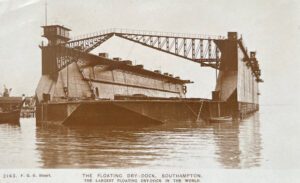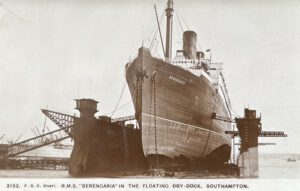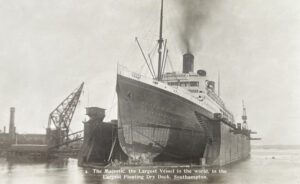27 June 1924 was a remarkably busy date in the diary of the thirty-year-old Prince of Wales. Edward Albert Christian George Andrew Patrick David – who would become King Edward VIII some twelve years later – began his day at London Waterloo, where he boarded a special train bound for the South Coast.
Southampton West (now Central) railway station had been bedecked with flags and evergreens and as the Prince stepped on to the platform, he was greeted by the Lord Lieutenant of Hampshire, Major John Edward Bernard ‘Jack’ Seely, 1st Baron Mottiston, and the Mayor of Southampton, Walter Mouland. The Prince made a short speech about the importance of Southampton as one of the gateways to England before making his way to a waiting car.
A guard of honour was formed and a military band played the national anthem. Thousands lined the route as the car took the Prince along Commercial Road to Above Bar Street. They travelled through the Bargate and down an extravagantly-decorated High Street to the Floating Bridge. The Floating Bridge took the Prince across the River Itchen and he soon arrived at the Supermarine Aviation Works on the banks of the river at Woolston. During a tour of the works, he met Reginald Joseph Mitchell, the man who would later design the Spitfire, and Henry Charles Biard, who had won the Schneider Trophy for Britain in 1922 in a Supermarine Sea Lion II, also designed by Mitchell and his team.
From Supermarine, the Prince ventured back across the Itchen, and proceeded to Southampton Docks, where the new floating dry dock was waiting. The dock was the largest of its kind in the world. 960 feet long and 170 feet wide, it stood 70 feet tall and weighed around 20,000 tons. It had been ordered in 1922 by the London and South Western Railway Company who operated Southampton Docks. By the time it was completed, the company had become the Southern Railway. The Thornycroft shipyard at Woolston had submitted a tender, but the contract was given to Sir W. G. Armstrong, Whitworth and Company of Newcastle-upon-Tyne. It was launched in 1923 and towed to Southampton by tugs in April 1924.

The enormous dock was located off Town Quay, at a special berth that had to be dredged in order to accommodate it. It was attached to land by four steel booms connected to four concrete dolphins. The dock would be emptied by fourteen pumps and when a ship was lifted out of the water, it would rest on rows of keel and bilge blocks.

The scene at the docks was ‘one of dazzling splendour’ with bunting over the main gate, and the route to the dock was described as an ‘avenue of colour’.[i] The Prince was treated to another guard of honour, this time from dock workers who proudly sported war medals, and the national anthem was played again.
The Prince of Wales made his way to a control cabin high up on one of the structure’s great walls, and he was shown how to operate the levers that would begin to sink the dock.
With the machinery stirred into action, the Prince walked back down the footbridge and made his way to RMS Aquitania, the largest British-built liner afloat at the time, which was affectionately known as the ‘Ship Beautiful’. The luxurious four-funnelled liner’s magnificent Louis XVI dining room – which had been lavishly decorated with flowers – was the scene of a luncheon for the Prince of Wales and the dignitaries who had followed him. The ship’s orchestra played for the guests and after yet another rendition of the national anthem, the Prince responded to a speech that had been given to him by the mayor. “I am enjoying my day at Southampton, and I shall certainly not forget this, my first visit,” the Prince of Wales concluded.[ii]
With lunch finished, the group progressed to the Southern Railway paddle steamer, Duchess of Fife. As she swung away from the ocean liner, Aquitania’s crew ‘swarmed on the ship’s rails, wildly cheering the sailor Prince.’[iii] Duchess of Fife took the Prince and his entourage through a red, white, and blue ribbon across the entrance of the now-submerged floating dock, thus completing the ceremony. The Hampshire Advertiser noted that it was ‘an historic trip – only occupying about ten minutes – but, although brief, it was momentous.’[iv] Many had gathered at Town Quay to watch the spectacle, and they would have cheered as the paddle steamer broke the ribbon. The enormous floating dry dock was officially open, and Southampton’s position as one of the country’s leading ports was secure. Prior to the opening of the dock at Southampton, the world’s largest liners had to go to Hamburg in Germany or Boston in the United States of America to use a floating dry dock of this size, something that cost the shipping companies both time and money. Now, large ships could enter one just yards from where they would ordinarily be berthed. It would not only benefit the shipowners, but also the port and town of Southampton itself.
The dock was open, but the Prince’s day was not quite over yet. Duchess of Fife returned him to the Royal Pier, where he changed his mode of transport. A car took him through more cheering crowds, through the Bargate again, then up Above Bar Street to Southampton’s Cenotaph, which had been designed by Sir Edwin Lutyens and unveiled on 6 November 1920. Members of the public swarmed around the Cenotaph, hoping to catch a glimpse of the royal visitor as he laid a ‘magnificent floral tribute’ on the base of the memorial, surrounded by hundreds of men and women who had served during the First World War. The wreath had been handed to him by two children, Edward and Winifred Sibley, whose father had been killed in France during the conflict.
From the Cenotaph, the Prince unveiled a memorial tablet at the Southampton branch of Toc H on Winchester Road in Bassett that honoured eighteen local Scouts who had died during the war. He then proceeded to the University College’s campus at Highfield.[v] He was shown around and the students cheered as he departed for his next engagement, a tour of the Royal South Hants Hospital. The Prince met patients, including one little boy who had been particularly eager to meet him. When the staff assembled in the corridors, the Prince made a point of greeting one nurse in particular who was wearing her war service medals.
‘Still brisk and charming in his manner,’ the Prince of Wales was then entertained to tea in the Royal Pier Pavilion by the Harbour Board, and he was joined by around seven hundred guests.[vi] “Thank you very much for the way you have received me this afternoon. I have had a most delightful day, and I am only sorry that it is drawing to a close,” he told them.[vii]
The Hampshire Advertiser reported that when the Prince left the Royal Pier, ‘he was followed with most enthusiastic cheers, and so dense was the crowd outside the pavilion that his motor car was brought practically to a standstill, and he was the centre of a wildly cheering crowd.’[viii] He then embarked upon ‘another triumphal progress’ back to Southampton West, where the mayor and mayoress bid him farewell.[ix] The mayoress handed him a souvenir programme before he boarded the train that soon steamed slowly out of the station to the sound of yet more cheering.
Around the same time the Prince of Wales had left the Cenotaph, RMS Arundel Castle had slipped into the dock. By the time the Prince left Southampton later that evening, the ship had been completely raised out of the water. By the end of 1924, some of the world’s greatest liners had been raised, including Olympic, Aquitania, Berengaria, and Belgenland.[x]

In March 1925, the dock successfully lifted the largest and heaviest ship in the world, RMS Majestic, an achievement described by the press as ‘one of the world’s greatest engineering feats’.[xi]

Eleven-and-a-half years after visiting Southampton, the Prince of Wales became King Edward VIII. His reign would last just three hundred and twenty-six days. The floating dry dock remained at Southampton throughout his short reign, but as war loomed less than three years after his abdication, a new chapter in the dock’s story was about to begin. During the early years of the Second World War, the dock was taken over by the Admiralty and towed to Portsmouth, where it played an important role as Admiralty Floating Dock No. 11. It remained at Portsmouth until 1959, when it was sold to a Dutch company and moved to Rotterdam. In 1984, the dock was sold to a Brazilian shipyard, but it was wrecked in a storm during the journey. Sixty years after it was opened by the Prince of Wales, the floating dry dock’s story had finally come to an end.
[i] Hampshire Advertiser, 28 June 1924.
[ii] Ibid.
[iii] Ibid.
[iv] Ibid.
[v] Now the University of Southampton’s Highfield Campus.
[vi] Ibid.
[vii] Ibid.
[viii] Ibid.
[ix] Ibid.
[x] Hampshire Advertiser, 27 December 1924.
[xi] Daily Mirror, 23 March 1925.

Author: Russell Masters
Bio: Russell Masters has been fascinated by the history of Southampton since childhood. Exploring the city’s past became a hobby and, in 2015, he set up a Twitter account to share his research with likeminded people. In 2020, he launched a website for blog posts and has published on a range of local history subjects. As well as blog posts, the website is also home to an interactive map, which was created by Russell that same year. The map shows the addresses of the Titanic crew members who lived or lodged in Southampton prior to the voyage and indicates whether or not they survived. The map provides a visual rendering of the catastrophic effect that the sinking had on the city and its people. Russell also collects Southampton-related postcards and enjoys researching the ordinary – and often extraordinary – lives of the senders and recipients.
Website: historicsouthampton.co.uk
Twitter: @HistoricalSoton
Facebook: @HistoricalSoton

